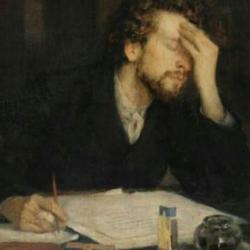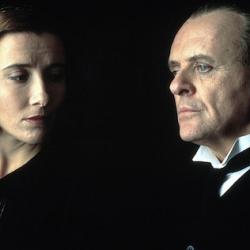All page numbers are from the Heany translation.
The central focus of the first two fights is Heorot, the mead-hall of Hrothgar. The mead-hall is the focus of a complex of imagery. (The last fight has a similar origin, as Beowulf’s hall is destroyed by the dragon. The house is a place where his warriors can celebrate and feast. As in the Odyssey and Macbeth, the feast is a microcosm of an ideal society, displaying on a small scale what an ideal world would look like. The mead hall itself is an architectural image of the people. As in the Bible, the building of the hall is a product of victory, and a public display of victory. Hrothgar received glory in battle, his band increased to a great company, then he built a mead-hall. He first builds a “house” of warriors and then a house for warriors.
The mead-hall is also a place of gift-giving and generosity, another key feature of heroic culture. Gifts bind people together, the warriors in loyalty to Hrothgar. Once Heorot is built: “Nor did he renege, but doled out rings and torques at the table” (p. 7). Thus, when Hrothgar turns Heorot over to Beowulf’s protection, he tells him “Never since my hand could hold a shield have I entrusted or given control of the Danes’ hall to anyone but you. Ward and guard it, for it is the greatest of houses” (p. 45). This is not merely the house that the Danes own but the national house. The significance of the hall is heightened by the surrounding country, a land of fens and bogs, haunts of monsters, bogs (p. 97, 99). As Beowulf journeys to the mere, he crosses a wilderness of untamed nature. The hall is an island of civilization, of feasting, song, poetry, gift-giving in a howling waste.
The poet not only associates the hall with civilization and order, but gives that a theological dimension. The hall is connected with creation and with an esechatological order. What angers Grendel about Heorot is not merely its existence but the songs of creation that are sung as it is build (p 9). Just as the hall was an ideal microcosm of the social world, so it was a microcosm of the creation. The hall represents creation organized for the purpose of man, for service to human happiness, fellowship, joy. The hall is not only Denmark on a small scale, but a restored, glorified Eden. It is commonplace that the central hall of a “primitive” civilization is a microcosm. The hall or palace is the place where the decisions are made that rule this world..
But “something is rotten in the state of Denmark,” and it is not just the fact that Grendel is attacking. No sooner built than the poet is already talking about its destruction (p 7). The poet looks forward already to the end of the civilization. The poem is about these beginnings and endings, and takes its melancholy, elegiac tone from this focus on loss. The poem begins with a description of the founding of a civilization: Scyld Shefing established an empire, subdued other nations and forced them to pay tribute. Even this description, however, is tinged with a sense of loss as it climaxes in Scyld’s funeral. The poem ends with the death of the hero, his funeral, and predictions of future destruction of the Geats. Enemies will take advantage of Beowulf’s death, and toward the end of the poem there is a long section on the future Swedish war.
The poem is about the collapse of the heroic world. The Danish court is crumbling. This is brought out in subtle ways in the poet’s description of the celebration that follows Grendel’s death. Grendel has been defeated, but there are internal problems in Denmark. Chief among these is the problem of succession (p 67). Hrothgar and Hrothulf, “father’s brother and brother’s son,” uncle and nephew, were friends “in those days” without any hint of falsity. But the time limitation suggests that in some other days this friendship will vanish. At another point in the poem (p. 83), the bond of uncle and nephew “was sound at that time, each was true to the other.” Unferth (“un-peace”) is there with them, who “toward his kinsmen he had not been kind at the clash of swords.” Wealhtheow is confident that Hrothulf, the nephew, will protect her children, Hrethric and Hrothmund, and argues that there is no need for Hrothgar to adopt Beowulf as his son (p. 63). But her speech is anxious, hinting at dark doubts that Hrothulf is going to do his duty and protect her children. Between these passages the song of Finn is sung. Finn (king of Frisians or Jutes) was married to Danish princess Hildeburgh to bring peace between the two. But while Hnaef (a Dane) is visiting his sister, he and her son are killed by Frisians. Danes, led by Hengest, forced concessions from Finn, but Hengest finally takes vengeance. The song points to the fragility of alliances based on marriage and vows, and casts considerable doubt on Hrothgar’s plan to solve his dispute with the Heathobards by giving his daughter as a bride (pp. 71ff). There is a cosmic scope to the poem. The beginnings are associated with creation, and at the end we are at the brink of the destruction of an entire people. It doesn’t happen, but the poem takes us to the edge, and leaves us hanging over it, at the edge of apocalypse.
This setting helps us understand the meaning of the monsters, which externalize the threats to heroic society. Tolkein saw the significance of the monsters for the poem. They are not, as some critics have charged, embarrassing folklorish intrusions in the poem. Rather, they represent principles of darkness, disorder, evil that threaten the heroic civilization embodied in Heorot. If the hall represents Denmark, the ideal society, the proper communion of men, and the creation, then the assault on the hall represents an assault on God’s world, the world of men. The monsters are demonic principles of disorder, disharmony, chaos. There is an opposition of society/exile, inside/outside hall, town/marsh running through the poem, reinforced by the imagery associated with the monsters, and the spatial mapping of the poem:
Monsters Beowulf
Night Day
Cain Abel
down Up
Isolation Society
Hall Fen
Grendel embodies chaos in one form. Grendel is a descendant of Cain, the outcast, the one driven not only from the garden but from the land of Eden. He is outside of the hall, outside of the circle of fellowship and gift-giving, and resents it and despises their happiness. He is also called God’s enemy. Grendel has no motive for his assaults on Heorot than simple resentment and anger that he has been excluded. He turns the place of feasting into a place of cannibalism, the civilized table into a savage meal. Grendel is a cyclopian monster, cannibalizing raw flesh. The connection between Grendel and the assault on creation is evident in the fact that Grendel’s Cainite ancestry is noted as soon as the creation song is mentioned (p. 9). Because of his terrorizing of the Danes, Grendel became the ruler of Heorot. He is a usurper, not a legitimate ruler, ruling he rules by fear and terror, not by law and custom, not by generosity and feasting. He embodies everything that is opposed to the settled and happy life of Danish society. As they battle, the poet calls Beowulf and Grendel the “claimants to Heorot.” Within Heorot, Grendel has something of a parallel in Unferth. When Beowulf shows up to deliver Heorot, Unferth provokes him with a taunt: “he could not allow that another man should hold under heaven a higher title to wonders in the world than went with his own name.” Unferth resents the reputation of Beowulf. In response, Beowulf says, “You have killed only kindred, kept your blade for those closest in blood; you’re a clever man, Unferth, but you’ll endure hell’s damnation
for that” (p. 41). Unferth is also a child of Cain. Unferth will later through treachery take the kingdom and become a usurper, as Grendel was. To put it into generalized and abstract terms, Grendel represents the threat that anger and resentment pose to civilized life, a threat that always exists. More sociologically, Grendel is the threat of the outsider, the exile.
Grendel’s mother represents a somewhat different sort of threat to Heorot. She does not act with the pure resentment and malevolence of her son. She is operating according to the principles of blood-feud: if you kill my kin, I will kill you. Grendel was an unsettled wandering type, but Grendel’s mother has a chamber, an anti-hall, and even has some things in it. She is more human than Grendel himself. As an embodiment of the blood feud, Grendel’s mother represents a more common “monster” that threatens heroic society. Blood feud was a constant barrier to civilized life. Again some digressions of the poem focus on this theme. The digression re Finn that precedes Grendel’s mother’s attack, and it is a song that deals with blood feuds that are not settled. This explains why it is Grendel’s mother rather than father who avenges him. Mothers concerned with kinship ties. Mothers are in the house, while fathers are in the city, the hall. The hall is the preserve of men, the place of masculine power and political counsel, which seeks to to overcome feminine insistence on kinship. As in Aeschylus, the opposition is between family and city, woman and man, politics and oaths and gifts v. Kinship. Grendel’s mother represents a false, demonic feminine order, an unmaternal order of uncivilization, a perverted order of kinship, which threatens the masculine and political order represented by Heorot. Grendel’s mother is a kind of negative of Danish world. Heorot is above ground, while Grendel’s mother has a chamber underground. She lives under water, and water is a frequent image in literature of chaos. Hers is a hellish alternative to the Eden of Heorot.
The dragon seems to represent a third kind of threat to heroic society, as a negative of the king. The dragon has all the vices that are opposite to heroic virtues. The hero acts out of devotion to his lord or to his people, but dragon acts out of malice. Dragons are sheerly destructive; the hero may use violence, but it is ultimately for constructive purposes. The hero, and especially the king, is a “ring-giver,” but the dragon hoards his treasures. The dragon, like Grendel’s mother, forms a parody of Heorot with all his treasures. It is fitting that Beowulf fights this anti-king after a long and successful reign. Digressions anticipate the fight with the dragon. The songs that immediately follow Beowulf’s victory over Grendel place Beowulf in the context of great heroes. The first is brief song of Sigemund, a dragon-killer, and there is also a song of Heremod, who promised to be a deliverer for his people, but evil gripped him. Hrothgar later expands on the negative example of Heremod, who attacked table companions and refused to give gifts. He was not openhanded, and Hrothgar is reminding Beowulf that open-handedness is the way to power. Beowulf has strength of hand as a hero, but as a king he has to have open hands. As a king, he will have to be an anti-dragon. For the Christian poet, the dragon no doubt had satanic overtones. As with Grendel’s mother, Beowulf again goes into the enemies lair to fight. He crushes the worm and secures the plunder for his people, dying in the midst of winning the battle, so that his death is the occasion of a great victory.















